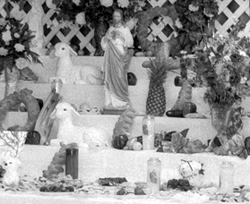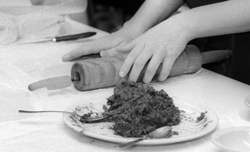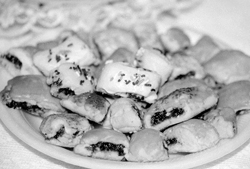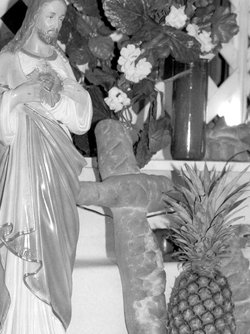Introduction to Delta Pieces: Northeast Louisiana Folklife
Map: Cultural Micro-Regions of the Delta, Northeast Louisiana

The Louisiana Delta: Land of Rivers








Ethnic Groups










Working in the Delta








Homemaking in the Delta



Worshiping in the Delta



Making Music in the Delta




Playing in the Delta







Telling Stories in the Delta



Delta Archival Materials
Bibliography

The St. Joseph's Day Altar Tradition In Monroe
By Stephanie Pierrotti and Madelyn Boudreaux
Editor's Note: On December 10, 1993, Stephanie Pierrotti interviewed Father Sam Pollacia, who was then the priest for St. Rita Catholic Church in Alexandria, Louisiana. Previously, he had served St. Joseph Parish in Monroe, where he worked with the Italian community on their St. Joseph's Day celebration. He also helped to develop St. Joseph altars in Powhattan when he served that community. The following March, as part of their work on the Delta Folklife Project, Stephanie Pierrotti and Madelyn Boudreaux attended and documented the cooking preparations by the St. Joseph's Altar Society and Men's Club for the 1994 St. Joseph's Day Altar at the St. Joseph's Catholic Church in Monroe, Louisiana. While the Altar Society does much of the cooking, the spaghetti sauce is prepared by the men. Today, St. Joseph's Church has merged with St. Matthew's, but they still have an altar society. The following three articles describe the complex work that goes into the preparation of the St. Joseph's Altar food preparation.
Father Sam Pollacia: On the Tradition of St. Joseph's Day
By Stephanie Pierrotti
Father Sam Pollacia, a second-generation Italian and a Catholic priest, encouraged his assigned Louisiana parishes to carry on the Italian tradition of St. Joseph's Day celebrations. It is interesting that he was able to maintain these traditions since his father came from Palermo as a child according to his family story. His father and aunt came to America in 1902. At the time of their immigration, Sam Pollacia's father was seven, his aunt, twelve. Father Sam's father was next in line to inherit some property in Italy, but the grandmother wanted him out of the country to clear the way for the family member who stood next in line for the inheritance. Their grandmother put the children on a ship in Palermo to send them to live with their uncle who was a farmer in Louisiana. She sent a letter to the uncle so that he would expect the children, but she unfortunately sent it on the same boat. The children and letter arrived at the same time. When the boat docked in New Orleans, no one was there to pick them up. Fortunately, a police chief who was also Italian took care of the children and brought them to his house. He contacted the children's uncle, who came to get them and brought them back to his home in Longbridge. The aunt married when she was fifteen and moved to Alexandria. Not long after, Sam Pollacia's father left to join her.
Origins of the St. Joseph's Altar
Pollacia grew up in Alexandria, and he remembers there being many St. Joseph's altars back then. He recalls that people usually had them at home, and they were given as requests for a favor from St. Joseph. As an adult, after he became a priest, he was interested in maintaining the tradition. When he was assigned to St. Joseph's parish in Monroe, he asked if they carried on the altar tradition. The parish had made altars, but it was not really an established tradition, so he set it up and helped them organize it. In 1964, the first year he was there, the community began work a month in advance. They had a huge celebration that year, and they have carried out the tradition ever since. He also started an altar at the Newman Center in Monroe, but he wasn't sure if it was still being continued today. Father Sam Pollacia outlines the origin of the annual St. Joseph's altar celebration. Before the turn of the century there was a drought in Southern Italy that lasted for seven years. People weren't able to raise wheat, so the citizens of a town promised that they would make an altar for the poor in honor of St. Joseph if the drought would end. Their prayers were answered, and they raised wheat enough to make up for the seven years that they had gone without. So they made an altar in the square in the center of the church and dedicated it to St. Joseph. They brought food to give to the poor; others who came to the feast brought donations for the poor. Italians, especially Sicilians, brought this custom with them when they came to America. The custom continued, usually as a request to St. Joseph to grant a favor. For example, according to Pollacia, around the time of war, people often gave an altar in hopes of a loved one's safe return. He told a story of man who went to war and whose mother promised a St. Joseph's altar every year until his return.
The Altar Tradition
According to Pollacia, the celebration begins on the eve of St. Joseph's day. The altar goes up that night. Altars include candles and either a statue or a picture of St. Joseph. A procession is held with four children who are chosen to represent the Santos (saints): Jesus, Mary, Joseph, and Ann, the mother of Mary. The children go from house to house and ask to be let in. If the altar isn't at that house, they are turned away; and this continues until they come to the house where the altar is. Dialog between the children and the ones who answered the doors was traditionally in Italian. When they finally found the right house, all the people would applaud. Wine and spinges (Italian donuts—fried and then rolled in confectionary sugar) would be served, and then everyone would say the rosary in Italian. Then everyone would leave until the St. Joseph celebration officially began on the following day.
On St. Joseph's Day, March 19, everybody met at noon and brought the food. Altars typically had four levels or steps: one for each of the four Santos. The four levels are filled with many different kinds of food. The children who play the Santos eat first. Fish, typically fried and the only type of meat at the St. Joseph's feast, reminds people of the Lenten season and they should eat in moderation. Fried fish was the only particular fish dish that Father Sam mentioned.
Altars also feature numerous kinds of baked goods on the altar. Biscottis, cookies made from a kind of biscuit dough, include fig cookies, jugilenas—seed cookies, and cookies filled with raisins, orange, and spice, along with anisette cookies are also included. Another special baked item are the cannolis, Italian cream puffs stuffed with ricotta cheese. Especially important are the fig pastries, which are baked into specific shapes: rooster, cross, fish, chalice, monstrance (the host receptacle made like a cross with a circle in the middle) —all with symbolic meanings. The rooster refers to the rooster that crowed after Peter denied Christ; the cross represents the crucifixion; the chalice and the monstrance symbolize the items used in communion. Father Sam Pollacia said that the fish refers back to the story of the fishes and loaves, but it might also refer to the fish as a symbol of Christ.
All the breads on the St. Joseph's altar are made in a particular way, according to a particular recipe that is only prepared for the St. Joseph's celebration. This bread contains much less yeast than regular bread. Therefore, it does not rise as much, is much firmer, and keeps for a longer period of time. They are formed into symbolic shapes: round (eternal God), cross, shepherd's staff (like a bishop's staff), and round with a cross in middle. There are also small, hand-sized loaves called St. Joseph's bread. These are for people to take with them when they leave. Recipients keep the bread in their houses for protection. If there is a storm, believers crumble the bread and scatter the crumbs to protect their house from the storm.
St. Joseph Recipes
Father Sam learned some of these recipes from his family, but he also picked up a great deal of them from different places he's been. The recipes vary. Cookies for example, differ from place to place. Traditionally, men take care of the pasta and the fried fish, and women prepare the baked goods. The spaghetti sauce is also prepared according to a special recipe. It uses no cheese, but toasted bread crumbs. Father Sam shares his recipe for the sauce:
Ingredients:
12 oz can of tomato paste
1 can of anchovy
2 large onions, chopped
5 cloves of garlic, chopped
1/2 cup raisins
1/4 cup pine nuts
3 tablespoons olive oil fennel greens
Boil the fennel greens in water until they are tender. Chop fine1y. Save the water. Fry onion and garlic in oil. Add tomato paste and four twelve-ounce cans of the fennel water. Add anchovy, raisins, pine nuts, salt, and pepper. Cook until thick.
Vegetable dishes are also important to the altar. Fried vegetables are called frozia. Cauliflower, spinach, cabbage, mustard greens, and stuffed artichokes are the usual. Another dish is carduna—artichoke plant leaves, which are boiled, skinned, destringed, and rolled in flour, and fried. They taste just like the artichoke hearts, according to Father Sam. Also on the altar are fava beans, or lucky beans, a very important non-food item. People take them home and carry them for luck. After the celebration, the leftover foods are given to the children. Foods from each of the four levels are bundled up and given to them to take home.
Cooking with the St. Joseph's Altar Society: March 14-19, 1994
By Stephanie Pierrotti
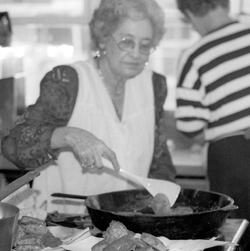
In 1994 St. Joseph's Catholic Church, in Monroe, Louisiana, has a very active Altar Society and Men's Club. The Altar Society, which meets monthly, performs the regular duties of an altar society and raises money for the yearly St. Joseph's altar, runs a soup kitchen, gives dinners for the area priests, and sponsors an annual spaghetti dinner.
Angie Maggio, who was serving as treasurer and had been the president of the group for many years, provided extensive information about the St. Joseph Altar and the members of the altar society. At the altar society meeting on February 20, 1994, the members finalized plans for collecting all the supplies needed for the cooking for the St. Joseph's Day altar. The list of supplies that would be necessary during the week-long altar preparations was extensive.
Preparations for Baking
Preparations for the altar were supposed to begin on the Monday before St. Joseph's Day on March 14. The altar society worked in the Activity Hall adjacent to the church. The large kitchen could accommodate about 15-20 busy people, with differing roles. Some of the women measured the ingredients, and some did the mixing. One woman, Ann Arthur, supervised, while others rolled the cookie dough and put it on the sheets. Another woman, Conchetta, ran the ovens, putting in and taking out sheet after sheet of cookies. With the exceptions of Ann Arthur and Conchetta, no one had any set job. At the end of the first day, Sarah Ticheli and Mamie Pitarro prepared the figs to be used for the next day's baking. They mixed together the dried figs and fig preserves and then ground them up by using a hand-turned grinder. They really preferred to use preserved figs over dried figs, but preserved figs are expensive. So they supplemented the donations of preserved figs with dried ones. Ticheli fed the figs into the grinder, and Pitarro turned the crank.
Making the Cookies
Monday through Thursday, the altar society members made all the cookies for the St. Joseph's Day celebration. Cookies of every kind were mixed, rolled out, baked, and decorated from nine in the morning until about three in the afternoon. The majority of these cookies were not the sort one would usually associate with Italian tradition: peanut butter, molasses, oatmeal, and chocolate chip, to name just a few.
The three types that stood out—those that had to be included because of tradition—were seed cookies, fig cookies, and biscotti. The type of dough used for seed cookies and fig cookies is very similar. It is a type of biscotti or "biscuit." The dough is only mildly sweet with a very subtle flavor. In making the seed cookies, one rolls out the dough into a long, rolled piece (as if making a play-dough snake), flattens the oblong piece slightly, cuts it into bite-size pieces, and rolls these pieces in sesame seeds.
Despite the similarity of the dough, the fig cookies are more difficult to make. In the first place, the dough must be precisely the right consistency: if it's too sticky, it's nearly impossible to roll; if it's too stiff, it breaks apart. Mixing the dough for these cookies was kind of a trial-and-error process at first. The first batch was very sticky, and even the seasoned cookie veterans had trouble with it. The mixers kept adding flour to it, hoping to improve the consistency. It didn't work. Questions as to whether or not the dough was the right consistency—really, questions on any stage of the ingredient-mixing process—were put to Mamie Pitarro or Sarah Ticheli, and occasionally to Ann Arthur. Generally, people deferred to their knowledge of the recipes.
The dough, rolled out with a rolling pin, stuck to everything—the table, the pin, the cooks, and even the wax paper in some instances. Once it was thin enough, a knife was used to trim the thin dough to make it somewhat rectangular—about 8 or 9 inches long and 3 1/2 inches wide. Next came the fig filling, which spread along the length of one of the longer sides of the section of dough to take up about a third or fourth of the width. Then came rolling out the cookie—the fun part. The rolling began with the side with the filling on it, and it was rolled over about twice and sealed. Angie Maggio suggested using a little water to seal the dough in order to prevent the filling from leaking out. Finally, the long roll is cut into smaller, bite-sized pieces that are placed on a greased cookie sheet. This is difficult enough when the dough has the right consistency. The cookies are supposed to look cute, not like mangled fig newtons. The next batch of dough was prepared according to a different recipe and worked much better. As the cookies were removed from the oven, they were left to cool. After cooling, they were ready to be decorated with icing. The completed, iced cookies were then stored and put away. While the altar society did not make the traditional dough and fig filling figures (the cross, fish, rooster, etc.), they did remember them from years past.
Making the Breads
On Friday, Mamie Pitarro, Ann Arthur, John Arthur, Angie Maggio, and one unidentified member of the men's club went to make the breads for the altar. This took place at a local bakery. The baker had the dough already mixed, so everyone else rolled out the bread. There were regular loaves enough to be sliced up and served to the 300 estimated guests and smaller loaves of St. Joseph's bread to be given away afterward. Some of the dough was shaped into some of the traditional forms: wreaths, artichokes, palm leaves, a cross, and a staff. Those who weren't involved in making bread stayed behind at the activity hall to wash and slice the vegetables in preparation for cooking the following day.
Final Preparations
Saturday was the last day of preparations since the altar was to take place later that evening. The men's club prepared the spaghetti sauce, along with the eggs that go with it; and the altar society cooked the vegetable dishes. John Arthur arranged the decorations and set up the items on the altar. The group usually has a statue of St. Joseph, along with other statues including Jesus and Mary, as well as the Italian colors of red, green, and white in various decorations such as flowers. Setting up the altar was finished around 3:00 p.m., and everyone went home to get ready for the 5:00 mass.
After mass, everyone went to the activity center. The priest blessed the altar, and then the four people chosen to represent the saints were served first. After that, everyone else ate and sat around to visit. There were approximately 100 to 150 people present—nowhere near the 300 that were anticipated.
Making Spaghetti Sauce with the St. Joseph's Men's Club
By Madelyn Boudreaux
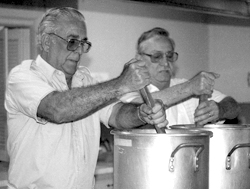
The St. Joseph Men's Club used to be called the Holy Name Society. According to the treasurer, John Arthur, the group changed its name because it had non-Catholic members. A priest told them that any Holy Name Society could only have Catholics, so rather than eliminate the non-Catholics (such as the manager of Wendy's. who donates the eggs for the spaghetti sauce each year), they changed the group's name. The group works with the Altar Society in planning and organizing the Saint Joseph's Altar each year. Members also do services around the church, such as cutting the grass, fixing the plumbing, and helping the priest with odd jobs.
While the women of the Altar Society do much of the cooking for the St. Joseph's Day altar, one important job is set aside for the men: the preparing of the sauce for the spaghetti to be served to the people who come to visit the altar and partake of the feast. The men in the club coordinated the tasks necessary to make the sauce.
Early Friday morning around 6 a.m., Louis Mitello prepared the onions (about 12 yellow ones), shallots, bell pepper, celery, and garlic by sautéing them for the "gravy," as he terms it. At 9 a.m. he was joined by Dominic Cascio, Tony Malta, and John Malta in the kitchen of the Madonna Room of the church, where the men began cooking enough sauce to feed the 300 expected people. The recipe is based on their family traditions, although they said they make it the same way every year for the altar for about fifteen years. For the sauce base, they used canned tomato paste and supplemented that with a jar of Prego. They commented that the store-bought kinds they used were "next to the best." For every gallon of tomato paste, they added two gallons of water, along with the spices including oregano. They cooked the sauce until 1 p.m. and "let it cool down."
Because of the Lenten fasting tradition and because it was in celebration of good crops, the tradition calls for no meat to be served; consequently, they eliminate all meat—even the Prego label was perused by all four before it was added. Instead of meat, they parboiled 300 eggs which were put in the gravy before it was served. They are very particular about when the eggs go into the sauce; they don't let the sauce boil after the eggs are put in because the eggs will get rubbery; however, they do warm the sauce again in the afternoon before it is served and add the eggs then to finish the cooking. This group doesn't use fennel in their sauce, although it is common at other altars. They eliminated it because most people don't care for the flavor. However, they do serve the sauce with "modega," slightly sweetened bread crumbs, which represent sawdust, in honor of Joseph's being a carpenter.
According to these men, the job of making the sauce falls to the men even in places that have no men's organizations. The men joked that they have to cook in a different kitchen from the ladies so that their colorful language will not offend anyone, but when I asked them why the ladies stayed away, they said it was because the ladies just don't want to do the work.



